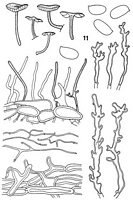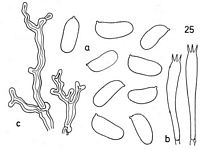|
 Heimiomyces atrofulvus Heimiomyces atrofulvus
SynonymsPanellus atrofulvus
BiostatusPresent in region - Indigenous. Endemic
Images (click to enlarge)
Caption: (ZT, 08/415): carpophores, spores, cheilocystidia, caulocystidia, cuticle | 
Caption: 25-Heimiomyces atrofulvus: a. spores; b. basidia; c. caulocystidia. |  |
Article: Horak, E. (1980) [1979]. Xeromphalina and Heimiomyces in Indomalaya and Autralasia. Sydowia 32: 131-153.
Description: Description of personal collections from New Zealand:
Pileus-20 mm, convex when young soon becoming plane or depressed, centre flat to subumbonate; dark red-brown with conspicuous yellow felty or velvety tomentum; dry, velvety to hairy, sometimes with low radially arranged veins at disc, membranous, tough, margin not striate. Lamellae (L 10-18, -3) crowded, broadly adnate to emarginate (decurrent with short tooth), ventricose; pale yellow turning yellow-brown, edge albofimbriate. Stipe-35 x -3 mm, cylindric or gradually enlarged into pileus, central; yellow-brown, with obvious orange tomentum over entire length; dry, entirely velvety to hairy, pruinose in upper portion, hollow, tough, single and cespitose, in groups. Context dark brown, gelatinous. Odour and taste acidulous or not distinctive. Spore print white.
Spores 7-10 x 4 -5 µm, elliptic, sometimes subcylindric to suballantoid, smooth, hyaline, amyloid, germ pore none. Basidia 25-40 x 5-7 µm, 4-spored. Cheilocystidia-60 x-6 µm, conspicuously branched, with irregular, numerous rod-like projections, membranes thick-walled, hyaline or yellow-brown. Pleurocystidia none. Caulocystidia like cheilocystidia but larger, membrane brown (KOH). Cuticle a palisade of erect, fasciculate, cylindric or subfusoid terminal cells (pilocystidia), membranes thick-walled, apex rounded, rarely with antler-like projections, intermixed with clavate to subovate thick-walled, strongly refractive cells. Structure of subcutis like H. neovelutinus (HONGO). Clamp connections numerous.
Habitat: On rotten wood in broad-leaved forest (dominated by Nothofagus sp., Weinmannia sp., Schefflera sp., Aristotelia sp. and Fuchsia sp.) or on soil (buried wood ?).-New Zealand.
Notes: For discussion compare H. neovelutipes (HONGO).
Article: Horak, E. (1971). A contribution towards the revision of the Agaricales (Fungi) from New Zealand. New Zealand Journal of Botany 9(3): 403-462 (http://www.rsnz.org/publish/abstracts.php).
Description: Panellus atrofulvus Stevenson (29 D) Fig. 2 = Heimiomyces atrofulvus
(Stevenson) comb. nov. (Basionym: P. atrofulvus Stevenson, Kew Bull. 19: 29,
1964)
Spores cylindric to slightly phaseoliform, hyaline, amyloid, thin-walled, without
germ-pore, 7.5-10.5 X 3.5-4.5 µ. Cheilocystidia none. Caulocystidia irregularly
branched, diverticulate, thick-walled, membrane coloured with brown pigment,
weak reaction in Melzer's solution, clamp connections present.
Article: Stevenson, G. (1964). The Agaricales of New Zealand: V. Kew Bulletin 19(1): 1-59.
Description: Pileus 1.5-2 cm diam., dark tawny, velvety fibrillose, convex to plane with an umbo; flesh ochraceous. Gills adnate, pale tawny, moderately distant. Stipe 1-2 cm x 3-4 mm, excentric, dark tawny, velvety fibrillose, hollow, tough. Spores 9-10 x 4 µm, amyloid (Fig. 6). Cuticle of loosely woven hyphae up to 5µm diam., tomentum of almost parallel unbranched hyphae, with slightly thickened tawny coloured walls.
Habitat: Strongly attached to fallen wood of Nothofagus, Hutt Valley, Wellington, 21.4.1958, Helen Druce in Stevenson (type).
|